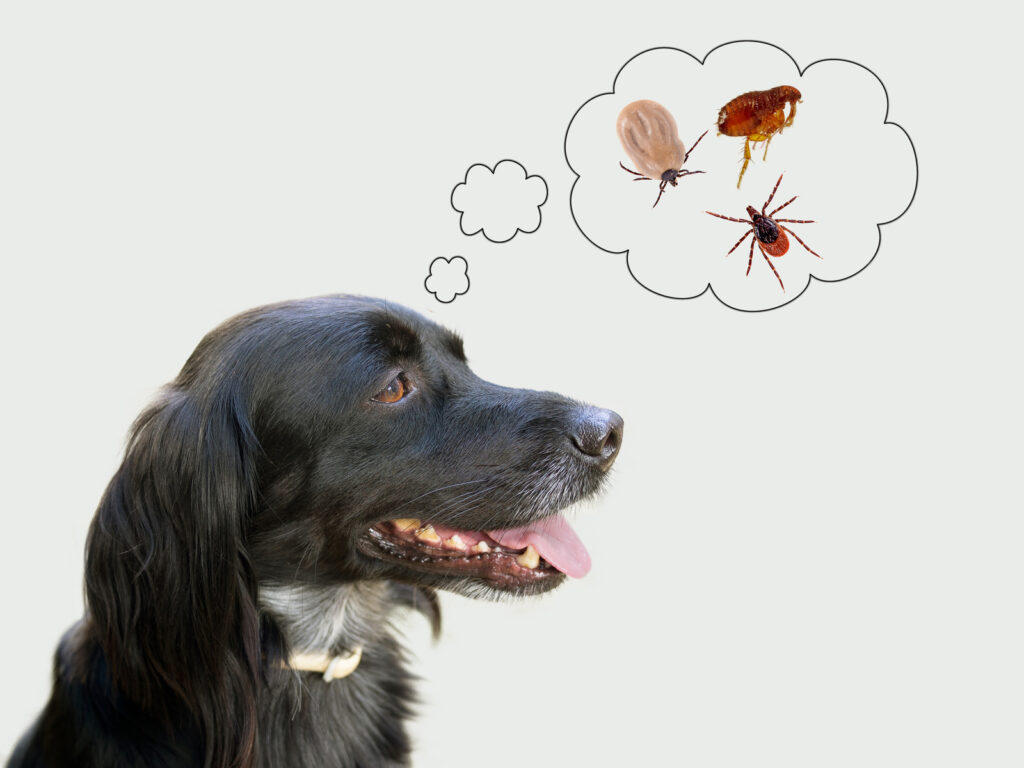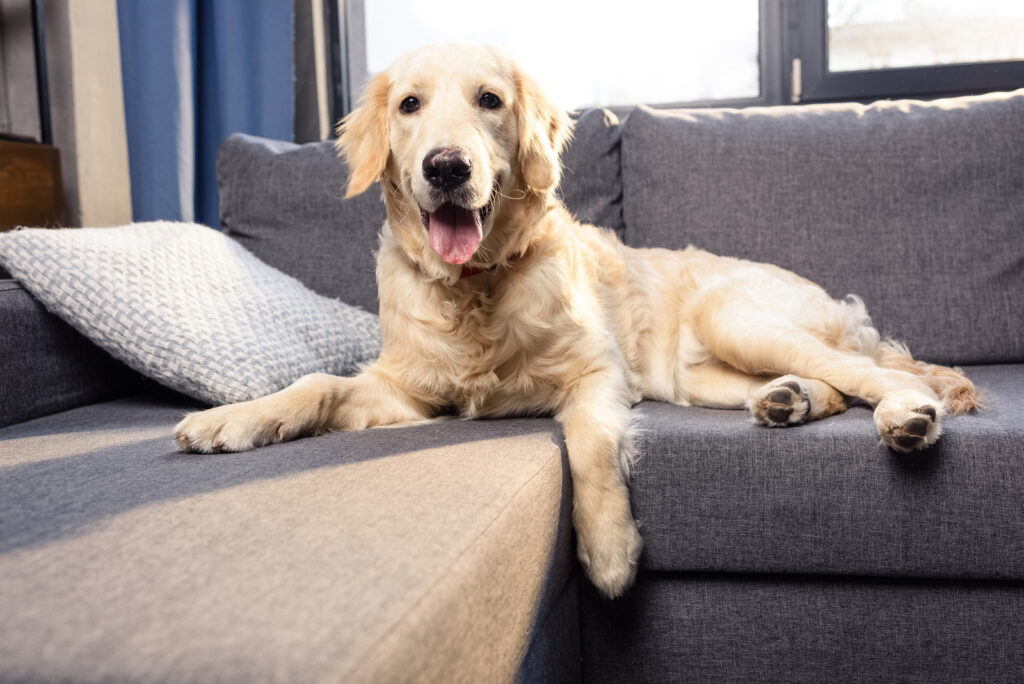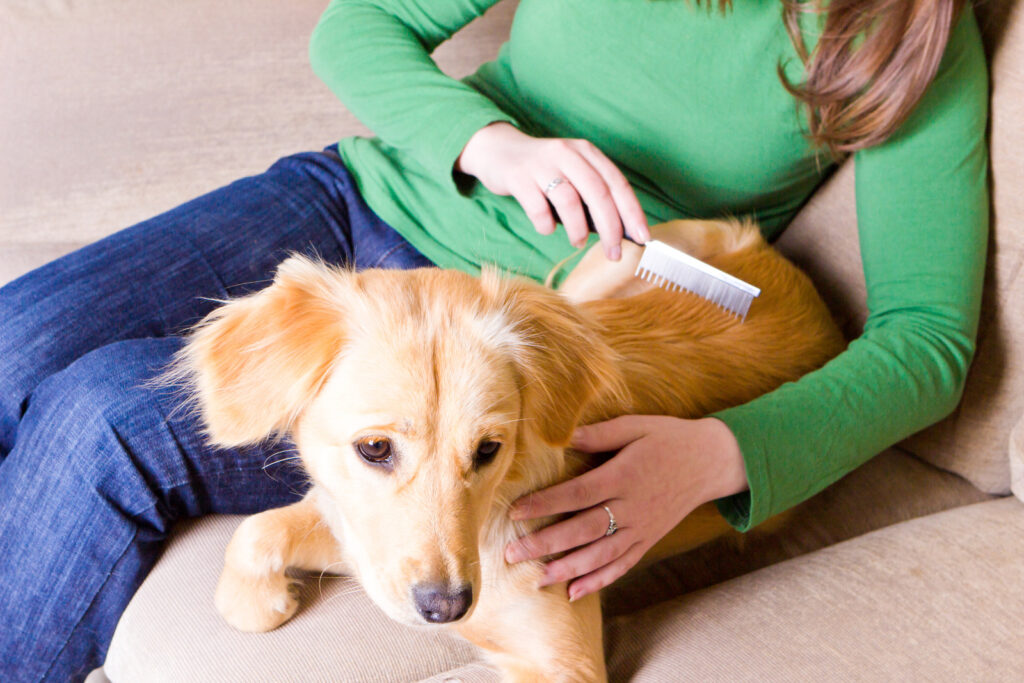And how can you prevent them?
Dog owners will know that fleas are an all-too-common problem, but these pesky critters can be hard to find. So how do you know if your dog has fleas? And how can you get rid of them once and for all? This article explains how dogs get fleas, the important signs to look out for and how to effectively treat your furry friend in order to say goodbye to fleas for good!
What do fleas look like?
Adult fleas are flat, wingless insects that are 1-2 millimetres long and dark brown in colour. They have six legs and can sometimes be seen crawling or jumping around in your pooches’ fur.
Their eggs look like white ovals that are normally only around half a millimetre long, making them tricky to spot with the naked eye.

How do I know if my dog has fleas?
It’s not always possible to spot fleas on your pet, as they spend a lot of time off your pup in the surrounding environment and will sometimes bury themselves in your dog’s coat. But there are often other signs you can look for that can tell you if your dog has fleas.
These signs include:
- Tiny brown flecks in your carpet or on your dog’s coat. These specks may be flea droppings and can be tested by placing the specks on a damp tissue. If the specks are flea droppings, they will produce red streaks from the blood the fleas have eaten- yuck!
- Pets starting to scratch more than normal. Your pooch may also start licking or nibbling at themselves- particularly their paws and in between their toes
- Skin changes. You dog may show signs of hair loss and bald patches may appear on their body. Their skin may also become sore and thickened and they will sometimes develop scabs
Signs of fleas (especially in the early stages) can be extremely subtle or sometimes non-existent. This means it is best to keep pets up to date with regular effective flea treatments in order to try prevent them from catching fleas in the first place, before the infestation progresses and becomes harder to tackle.
How do dogs get fleas?
Fleas have very strong back legs which means they can jump onto your pet from quite a distance! Your dog will often catch these pesky critters from other animals (most commonly cats and other dogs), and also from environments that are already infested.
Fleas’ lifecycle?
- During their lifetime, fleas can lay hundreds of eggs!
- These eggs fall off pets onto flooring/bedding/soil/carpets.
- The eggs then hatch into flea larvae which settle away from the light before spinning themselves into a cocoon.
- The flea larvae can live for up to a whole year inside these cocoons, waiting for the right conditions to emerge.
- Once the fleas have emerged from their cocoons, they will look for a pet to jump onto so they can start feeding. Once on your pooch, fleas can survive by biting them in order to feed off their blood.
How long do fleas live?
The flea lifecycle can last as little as 12-14 days, but the larvae can remain dormant in the cocoon for as long as 180 days waiting to emerge- one of the many reasons why it’s really important to keep you pup protected with regular treatments.
How to get rid of fleas.
Flea treatments are best used to prevent your pup from catching fleas in the first place, rather than as a treatment for when your pooch already has fleas. Keeping your doggo up to date with regular flea treatments will often allow you to avoid the uncomfortable and sometimes serious signs that you and your pup can develop as a result of a flea infestation. If pups are not kept up to date with regular flea treatments, it can take up to 90 days to get rid of a nasty flea burden!
Flea treatments come in lots of different forms including spot-ons, tablet, sprays, shampoos and flea collars. It’s worth noting that there are a huge variety of flea treatments which include both over the counter and prescriptions products. It’s therefore important to select a treatment that is suitable for your pet as different types of flea treatments work better in some animals than others. For example, some pups are highly sensitive to the noise of a flea spray and some dogs will refuse to take tablets whilst others don’t like to be washed with a flea shampoo. It’s all about finding a treatment that works best for your pup!
Flea treatments can also differ in how they actually treat the fleas, with many spot-ons working to kill adult fleas and flea larvae, whilst some flea collars actually act to repel the fleas away from the animal.

Treating the house for fleas
Some vets advise treating your house with environmental flea sprays (in addition to treating your pet) in order to get rid of flea burdens more quickly. Vets will also sometimes advise washing any animal bedding on a 60-degree wash, again to help to eliminate the fleas faster. It’s worth noting that, because fleas can stay dormant in their cocoons for several weeks, it’s possible to move into an animal-free house and still find fleas! In this case it’s important to hoover the house thoroughly as dogs can get fleas from their environment. The vibrations from the vacuum will cause the fleas to emerge from their cocoons- meaning that you are able to treat them more effectively- in this case an environmental flea spray is normally a suitable treatment.
Finding fleas after treatment
Contrary to popular belief, it’s still possible to find fleas on pets that are fully treated and protected against flea infestations. This is because no flea treatments repel fleas from jumping on your animal completely. But don’t fret! Whilst these critters can jump onto your pooch like a little hitchhiker, their flea treatment should prevent them from setting up camp and living on your pup.

It’s worth noting that flea treatments normally don’t work instantly and can take hours or even days to work. So, again, seeing fleas on your animal after treatment doesn’t always meant that their treatment hasn’t worked.
What do flea bites look like?
You may not see flea bites at all! Some animals and humans do not react to fleas and so bites do not produce any symptoms. Because of this, it’s important not to assume your pet is free from fleas just because you can’t see any bites!
Sometimes flea bites can look like raised red dots that can appear on the skin of both animals and humans. And, in some cases, flea bites can lead to more serious allergic skin reactions.
How to treat flea bites.
It’s important to remember that fleas are often completely preventable, and by keeping pets up to date with regularly treatments, owners are often able to prevent their animals from becoming infested with fleas, therefore reducing the chances of fleas biting them and their pet.
As mentioned previously, many humans and animals do not react to flea bites, so you may not see any bites at all, even when you have a significant flea burden. And even if they do react, most humans and pets will only have a mild skin irritation, which often doesn’t require treatment.
That being said, people and animals can sometimes develop more serious allergic reactions to flea bites, so if you find your pet’s skin becomes extremely itchy and uncomfortable and are suspicious of an allergic reaction, it’s always best to speak to your vet (or your GP if you are suffering from a reaction yourself) who will be able to advise you regarding appropriate treatment.
Fleas and worms
It is possible for fleas to carry tapeworm eggs. And this means that your pooch can catch tapeworm through accidentally ingesting infected fleas.
This is yet another reason why it is important to keep up to date with regular flea prevention treatments. Some treatments will handily treat fleas and worms at the same time, making parasitic treatment easier and more convenient.


